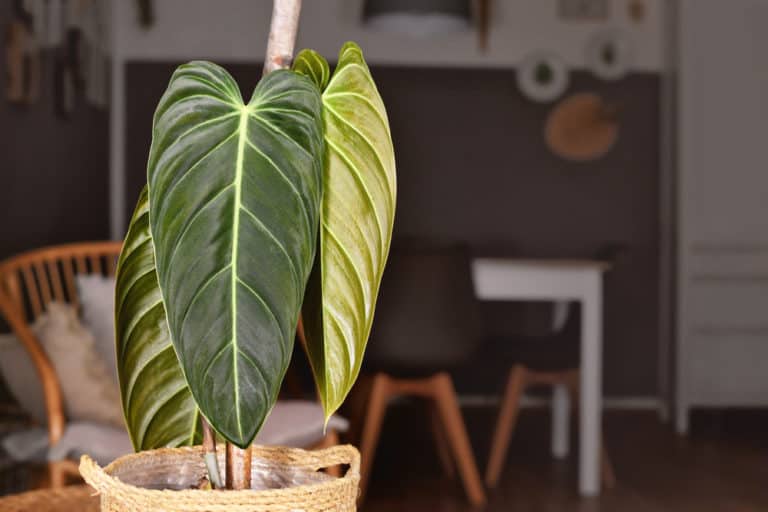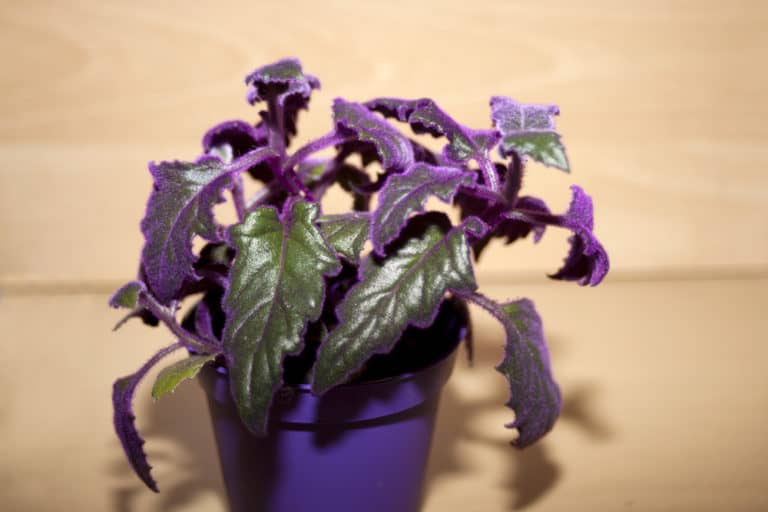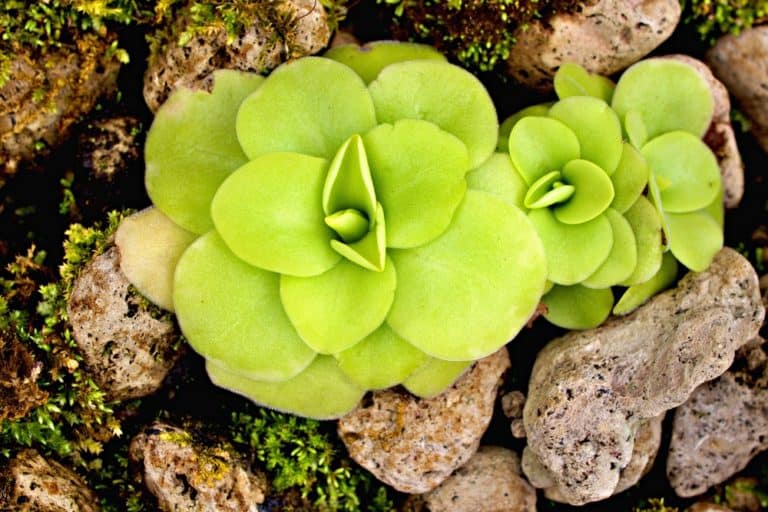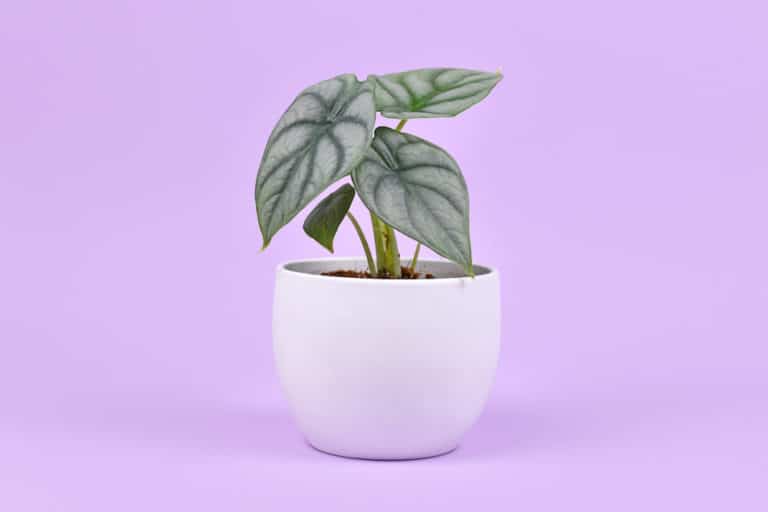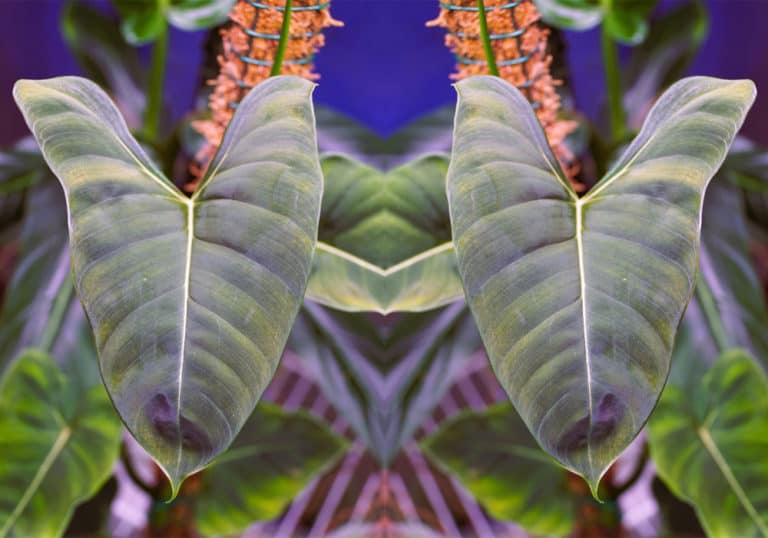Scindapsus Treubii ‘Moonlight’ Care Guide (2024)
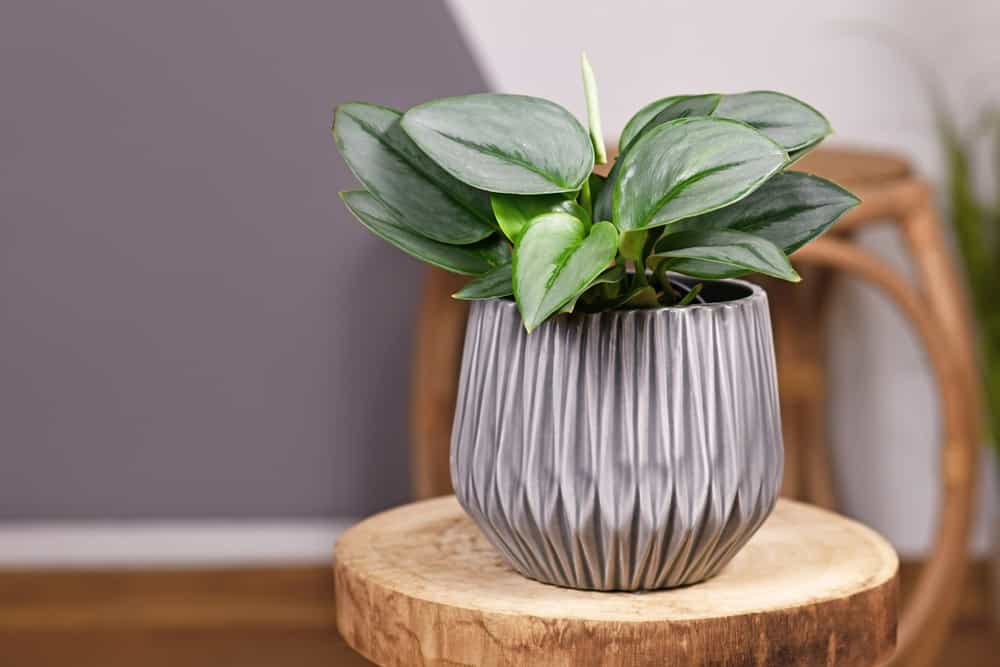
Scindapsus treubii is really trendy right now, and with good reason.
The unique silvery leaves of the most popular variety, treubii ‘Moonlight’, have made it one of the most desirable houseplants for even the beginner to cultivate.
Needing a minimal amount of care to keep it thriving, it’s an excellent addition to your indoor garden.
| Scientific Name | Scindapsus treubii |
| Common Name | Sterling Silver scindapsus, Moonlight scindapsus, Dark Form scindapsus |
| Light | Bright indirect sunlight |
| Watering | Weekly, water if soil is dry |
| Temperature | 65 to 75ºF (18 to 24ºC) |
| Hardiness Zone | 10a |
| Humidity | 40-60% |
| Soil Type | Porous, quick-draining |
| Soil pH | 5-8 pH (neutral to low-acid) |
| Fertilizing | A high-nitrogen feed once a month in spring and summer |
| Repotting | Every 2 years |
| Pruning | Beginning of the growing season |
| Propagation | Root in water or soil |
| Toxicity | Toxic to humans and pets |
| Mature Size | 6-8 feet (1.5-2 meters) |
| Bloom Time | Rarely in summer |
What’s Unique About Scindapsus treubii?
The outstanding characteristic of ‘Moonlight’, the most commonly available variety of Scindapsus treubii, is the beautiful silvery sheen on its thick, glossy leaves. It’s also known as ‘Sterling Silver’.
The other variety usually available, scindapsus ‘Dark Form’, differs in that its leaves appear almost black, for a really dramatic look.
When coupled with the ease of care for this low-maintenance plant, it’s clearly a winner for those looking for an attractive houseplant.
Native to the jungles of southeast Asia, growing Scindapsus treubii will bring a tropical touch to your home at the same time that it purifies your air for a healthier indoor environment.
Scindapsus treubii Care
Scindapsus treubii plant care is easy even for a beginner. Keep the plant in bright but filtered light away from full sun.
Water only when the soil is dry, and fertilize once a month in the growing season. Maintain a warm, humid environment for this tropical plant.
See below for more details on treubii ‘Moonlight’ care.
Light
Scindapsus treubii light requirements are not difficult to meet, even without any special equipment.
It originates in the jungles of southeast Asia, and so grows best with bright but indirect sunlight.
Treubii moonlight light needs are perfect for indoor settings. They will thrive with light levels ranging from 10,000-20,000 lux.
This can easily be achieved by placing them by an east window, or in a south-facing room out of the direct sun.
Even in low-light settings, it will be fine without a grow light; it will just grow more slowly.
Too much light can burn the leaves and stunt its growth, so be sure to avoid extended periods in full sun.
Watering
The watering needs for your Scindapsus treubii plant are pretty straightforward: keep things dry!
In their native jungles, they are used to low soil moisture, and will suffer from root rot if their soil is too wet.
Rather than keeping to a regular schedule, it’s best to water treubii ‘Moonlight’ only when the soil is almost completely dry.
A quick way to determine if it’s time for Scindapsus treubii watering is by the weight of the pot. If it’s heavy, there’s enough water to keep it going.
When it’s drying out, the pot will be lighter. Check with your finger to confirm that the soil moisture is low. If it’s really dry, you will see the leaves curling under slightly.
Soak the soil thoroughly but do not let the pot sit in water.
Temperature
The ideal Scindapsus treubii temperature range is on the warm side, as it is native to the tropics.
They will do best between 65-75°F (18-24°C), but have a temperature tolerance between 55-85°F(13-30°C).
Too high a temperature for treubii ‘Moonlight’ can lead to the foliage wilting, while too low a temperature will stunt its growth.
They have no frost hardiness, so do not keep plants outside when temperatures drop in the fall, and keep plants away from windows in cold winter weather. Even being in the direct way of a fan or air conditioner can damage the plant if it’s too cold.
Humidity
Scindapsus treubii humidity requirements are typical for a jungle plant used to a tropical, moist environment.
The ideal humidity for treubii ‘Moonlight’ is around 60%, but it will tolerate a humidity level as low as 40% without ill effect.
If your home’s humidity rate is around 40%, your Scindapsus treubii plants will probably be fine, but if the leaves start to get a bit crispy and yellow, it’s time to give them a boost.
You could use a humidifier to raise the humidity in the air, but a less expensive solution is to simply mist the plants every few days. Use distilled water to prevent the build-up of minerals on the leaves.
Soil
Scindapsus treubii soil has one main requirement: it must be porous and well-draining to prevent roots from rotting.
The pH level for treubii ‘Moonlight’ is not as important, as it will be happy with anything from 5-8 pH.
You can use a commercial cactus or succulent soil mix with great success, as those plants have the same requirement for porous soil.
If you want to mix your own soil for treubii ‘Moonlight’, you can combine equal portions of perlite, vermiculite, and peat moss.
Coco coir is a good alternative to peat moss, as its production is more eco-friendly than harvesting from non-renewable peat bogs.
Fertilizer
You will want to apply fertilizer on a regular basis during the growing season to keep the foliage lush and attractive.
Once a month during the spring and summer should be enough fertilizer for treubii ‘Moonlight’.
Stop feeding in the fall and winter when the plant enters its dormant period.
The ideal fertilizer ratio for this foliage plant is 20-10-10, as the extra nitrogen will help the leaves grow better, but a balanced ratio will also work.
An organic liquid formula will be a perfect Scindapsus treubii fertilizer.
Adding compost to the soil mix will also add soil fertility for healthy growth.
Potting & Repotting
Repotting treubii ‘Moonlight’ is only necessary when it has clearly outgrown its current pot, and you see roots growing out of the drainage holes.
This may take several years to happen, so don’t rush it. Repotting too frequently can actually damage the plant.
When it is time for Scindapsus treubii repotting, select a terra cotta pot with drainage holes so that the soil can drain freely.
Only increase the pot size by 2 inches in diameter. Use a potting soil as described above, and water it well to let it settle in.
Consider adding a sphagnum stick to encourage it to climb and develop aerial roots.
Pruning
You may never need to trim your Scindapsus treubii, but it is possible to do it for aesthetic reasons.
Of course you will want to remove any dead or damaged leaves to preserve the beautiful appearance of this foliage plant.
If the plant is becoming overgrown, you can cut out all of the old, woody stems to encourage fresh new growth.
If you do want to do some Scindapsus treubii pruning, only do so in the spring when its dormancy has ended and the plant has begun its fresh growth.
When cutting treubii ‘Moonlight’, use a sharp knife or scissors to remove the leaves or stems without damaging the plant.
Propagation
Scindapsus treubii propagation is easy to do.
The easiest way to propagate treubii ‘Moonlight’ is by dividing plants when repotting. Gently pull the roots apart and pot up each plant as described above.
Most people, however, propagate Scindapsus treubii by taking cuttings and rooting them, as you don’t have to wait until repotting to get new plants.
The best method is to take stem cuttings just below a leaf node, and stick them into a cup filled with perlite and sphagnum moss, or into a glass of water.
Keep the humidity high by covering it with a plastic bag, and keep in a warm spot for a few weeks until strong roots develop.
Pot the baby plants as described above.
Common Problems of Scindapsus treubii
Scindapsus treubii problems are few and far between, and luckily can be quickly cleared up when caught early.
The leaves rarely get insect pests and they can be controlled with organic sprays.
Any disease problems with treubii ‘Moonlight’ can usually be prevented or cured by maintaining the dry soil conditions that it prefers.
Pests
Treubii ‘Moonlight’ is relatively free of serious pest problems, but it’s good to know what to look out for.
While many growers report never seeing any Scindapsus treubii pests, it is possible for them to be infested with spider mites, aphids, or mealybugs.
Spider mites can be identified by little light dots on the underside of leaves.
Aphids leave a sticky substance on leaves, and tend to gather on fresh growth or the underside of leaves.
Mealybugs look like small puffs of cotton on the leaves.
Luckily, all three bugs can be controlled with an insecticidal soap spray or pyrethrum for more severe infestations.
Diseases
There are very few Scindapsus treubii diseases, and it is easy to prevent them through proper care.
You may find your treubii ‘Moonlight’ has developed mold as a result of too damp soil.
You will see yellow or blackening leaves if this is the case. Repot the plant in fresh, well-draining soil and keep it on the dry side from then on.
Neem oil spray will help kill any fungus that may have developed from the damp conditions.
If you see signs of cream or brown woody growths near the soil, your plant has crown gall, and should be destroyed to avoid it spreading to other plants. Luckily, this disease rarely affects Scindapsus treubii.
Growing Problems
Scindapsus treubii rarely experiences growing problems, and they can usually be prevented or solved with proper cultivation.
Root rot will develop if the soil is too wet from overwatering. In that case, the leaves will start to get yellow or black spots and soften. Repot the sick plant in well-draining soil and cut back on your watering.
If leaves start to appear yellow and brittle, you may be letting the soil dry out too much. Water more frequently.
They may also be yellowing because of too bright sun. Move it further away from the light source to let it recover.
Toxicity of Scindapsus treubii
As with all members of the pothos family, treubii ‘Moonlight’ is toxic to pets and humans because of its insoluble calcium oxalates.
Caution should be used when growing this plant in a home with children and/or pets.
However, choosing a spot out of reach will eliminate the toxicity risk to the human and non-human members of your household.
For Humans
Scindapsus treubii is toxic to humans, and is especially a poisoning risk for children.
Because of their smaller body size,even a small dose of the toxin can cause a serious reaction.
If a child ingests treubii ‘Moonlight’, they may experience swelling of the tongue, mouth, and lips, and start vomiting.
For a mild exposure, clean any plant matter from their face and mouth, and give them a cool snack or drink to ease the pain.
If they have difficulty breathing, take them for medical care immediately.
You may also get a reaction from skin exposure to treubii ‘Moonlight’. Rinse the affected area thoroughly with warm water and soap.
For Pets
Cats and dogs are also at risk from ingesting treubii ‘Moonlight’.
After consuming Scindapsus treubii foliage, pets may develop swollen lips, mouth, and tongue, and drool excessively.
They may also start vomiting and develop diarrhea.
Severe cases can lead to kidney damage and eventual death.
If you suspect that your pet has eaten some of your Scindapsus treubii, contact your veterinarian immediately.
You can still enjoy the beauty of this tropical plant if you have pets, as long as you take some common sense precautions.
Scindapsus treubii can grow very happily in a hanging basket or on a high shelf out of reach of cats and dogs.
Scindapsus treubii Appearance
The Scindapsus treubii appearance is striking and has made it one of the most popular houseplants right now.
It is desirable because of the color of its leaves and its vining growth habit.
You can choose between the silver of Scindapsus treubii ‘Moonlight’, darkness of Scindapsus treubii ‘Dark Form’, or brightness of Scindapsus treubii ‘Mint’, or grow all three.
Foliage
The foliage of Scindapsus treubii is definitely the star of the show.
At maturity, a leaf can be from 4 to 20 inches long. They are oval or heart-shaped.
They are thick, with a smooth, slightly glossy texture.
Scindapsus treubii ‘Moonlight’ has green leaves overlaid with a silvery sheen.
Scindapsus treubii ‘Dark Form’ is almost black in certain lights.
The more rare Scindapsus treubii ‘Mint’ has a marbled, light green pattern on its leaves.
Leaves will grow larger in warmer conditions that are closer to Scindapsus treubii’s native jungle.
As they mature they may become longer and narrower, or develop lobes along the edges.
Flowering
If you grow your Scindapsus treubii indoors, you are likely to never see a treubii ‘Moonlight’ flower, but under perfect conditions blooming is possible.
Scindapsus treubii flowering is only likely if you are growing the plant outside in hot, humid conditions similar to its native jungle home.
The flowers are small and unremarkable, but if you want to encourage flowering, you will have to create the perfect growing conditions.
Find a spot on your patio or garden with filtered sunlight or semi shade where you can place your potted plants for the hot summer season, and wait to see what develops.
Size and Growth
The size of Scindapsus treubii depends to a certain extent on the growing conditions that you can provide for this tropical jungle plant.
Under ideal conditions, it can grow to 6 to 8 feet tall when its natural vining growth habit is supported by a sphagnum stick.
It can also grow along a shelf or other horizontal support. Try to provide something with organic material to allow its aerial roots to develop.
Its growth rate is slow but steady through its active growing seasons of spring and summer. It may take several years for it to reach its mature size.
Scindapsus treubii Fragrance
The only time you will detect any scent is if your Scindapsus treubii blooms, as it is only the flowers that have a fragrance.
Since blooming is very rare and usually will only occur outside, if you are growing it exclusively indoors do not expect to smell any Scindapsus treubii fragrance.
This makes it an excellent choice for public spaces where strong scents are discouraged, such as fragrance-free medical facilities or residences.
In your own home, if you are sensitive to fragrances this foliage plant is a good choice to ensure a fragrance-free environment.
When Scindapsus treubii does produce flowers, the scent is sweet and pleasant.
Suggested Uses for Scindapsus Treubii
Scindapsus treubii is an excellent houseplant for decorative purposes, and as an air purifier.
NASA has included it on its list of air-purifying plants, clearing the air of harmful chemicals such as formaldehyde.
Its beautiful foliage and vining habit makes it an attractive as well as useful indoors plant.
Using it in your bedroom as a hanging plant, with support allowing it to climb, will beautify your space while it cleans the air.
It will also thrive in the warm, humid air of a bathroom or sunroom, as long as it is kept out of direct sunlight.
Even in low-light conditions it will grow, although more slowly, giving you lots of options for using it as a decorative plant.
FAQ
What is Scindapsus treubii?
Scindapsus treubii is a vining perennial plant native to the jungles of southeast Asia and the western Pacific, now grown as a houseplant for its attractive foliage.
How to identify Scindapsus treubii?
Scindapsus treubii has long, heart-shaped leaves with a thick, slightly glossy texture that are silvery, dark, or mottled green in appearance, growing on a vining plant.
How to care for Scindapsus treubii?
Plant Scindapsus treubii in porous, well-draining soil and keep the soil on the dry side. Fertilize monthly in its growing season with a high-nitrogen fertilizer.
How to grow Scindapsus treubii indoors?
Place it in a location with bright but indirect sunlight. As it grows, provide the vine with support to allow it to grow to its full length.
How to grow Scindapsus treubii outdoors?
Place your pots of Scindapsus treubii in sheltered spots where they will receive protection from the direct sun. Water only when the soil is dry.
How fast does Scindapsus treubii grow?
Scindapsus treubii plants may take several years to reach their full size, depending on how close their growing conditions are to its native jungle home.
How tall does Scindapsus treubii grow?
Scindapsus treubii can grow to 6 to 8 feet in length/height. It grows as a vine either vertically or horizontally depending on the support provided.
How to make Scindapsus treubii grow faster?
Scindapsus treubii will grow the fastest when given its ideal conditions of warm temperatures, fairly high humidity, regular fertilization, growing supports, and bright, indirect light.
How to stake Scindapsus treubii?
Support your Scindapsus treubii with a sphagnum stick to allow it to climb to its full length. A support with organic matter will allow its aerial roots to form.
How to pot Scindapsus treubii?
Scindapsus treubii should be potted in porous, well-draining soil such as a cactus or succulent soil mix. Terra cotta pots with drainage holes are recommended.
How to revive Scindapsus treubii?
If your Scindapsus treubii has dried out completely, plunge the whole pot in water and let the soil fully absorb the moisture before letting it drain the excess water.
Why is my Scindapsus treubii dying?
Your Scindapsus treubii may have completely dry soil, or too much water. Determine which is the case and either soak the soil thoroughly or repot in better draining soil.
Why is my Scindapsus treubii drooping?
Your Scindapsus treubii may have completely dry soil which can lead to wilting leaves. Soak the soil and let the excess drain off to revive it.
How cold can Scindapsus treubii tolerate?
Scindapsus treubii are tropical plants and so cannot tolerate temperatures lower than 55°F (13°C) without suffering damage. They will be killed outright by freezing temperatures.
How to get rid of pests on Scindapsus treubii?
Use sprays such as insecticidal soaps, pyrethrum, or neem oil for pests. For mild infestations you can remove pests by hand or with a gentle spray of water.
Is Scindapsus treubii toxic to cats?
Yes, Scindapsus treubii is toxic to cats. Keep plants out of their reach in hanging baskets or on high shelves to prevent them from nibbling on the foliage.
Is Scindapsus treubii toxic to dogs?
Yes, Scindapsus treubii is toxic to dogs. If your dog has a swollen mouth or tongue and is vomiting or has diarrhea, take him to the veterinarian immediately.
Is Scindapsus treubii toxic to children?
Yes, Scindapsus treubii is toxic to children. Keep plants out of their reach, and if they ingest some of the foliage, consult with a doctor immediately.
Is Scindapsus treubii toxic to humans?
Yes, Scindapsus treubii is toxic to humans. Adults may have a reaction to the plant sap. If irritation develops, rinse the affected skin with soap and water.
Does Scindapsus treubii have a scent?
Scindapsus treubii foliage has no smell, but the small, insignificant flowers have a sweet scent. However, these plants rarely bloom, and almost never when grown indoors.

